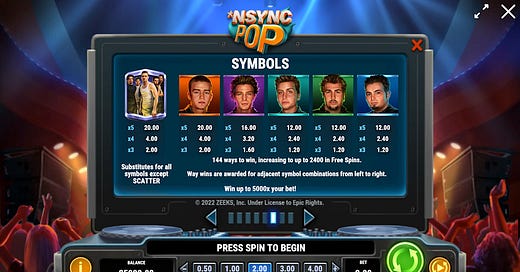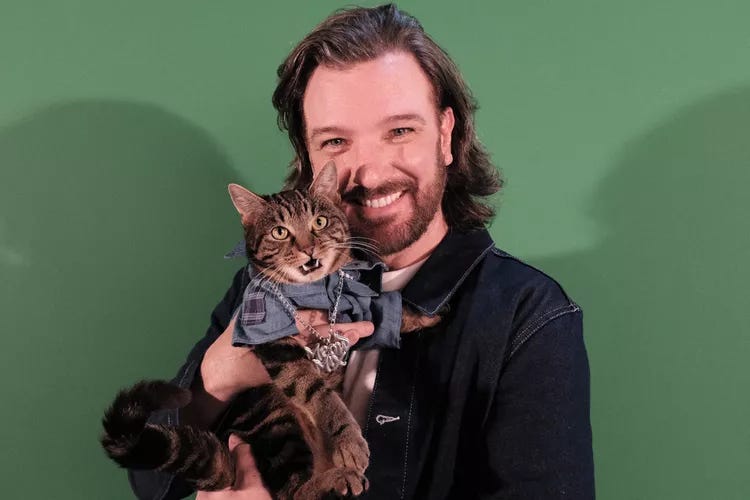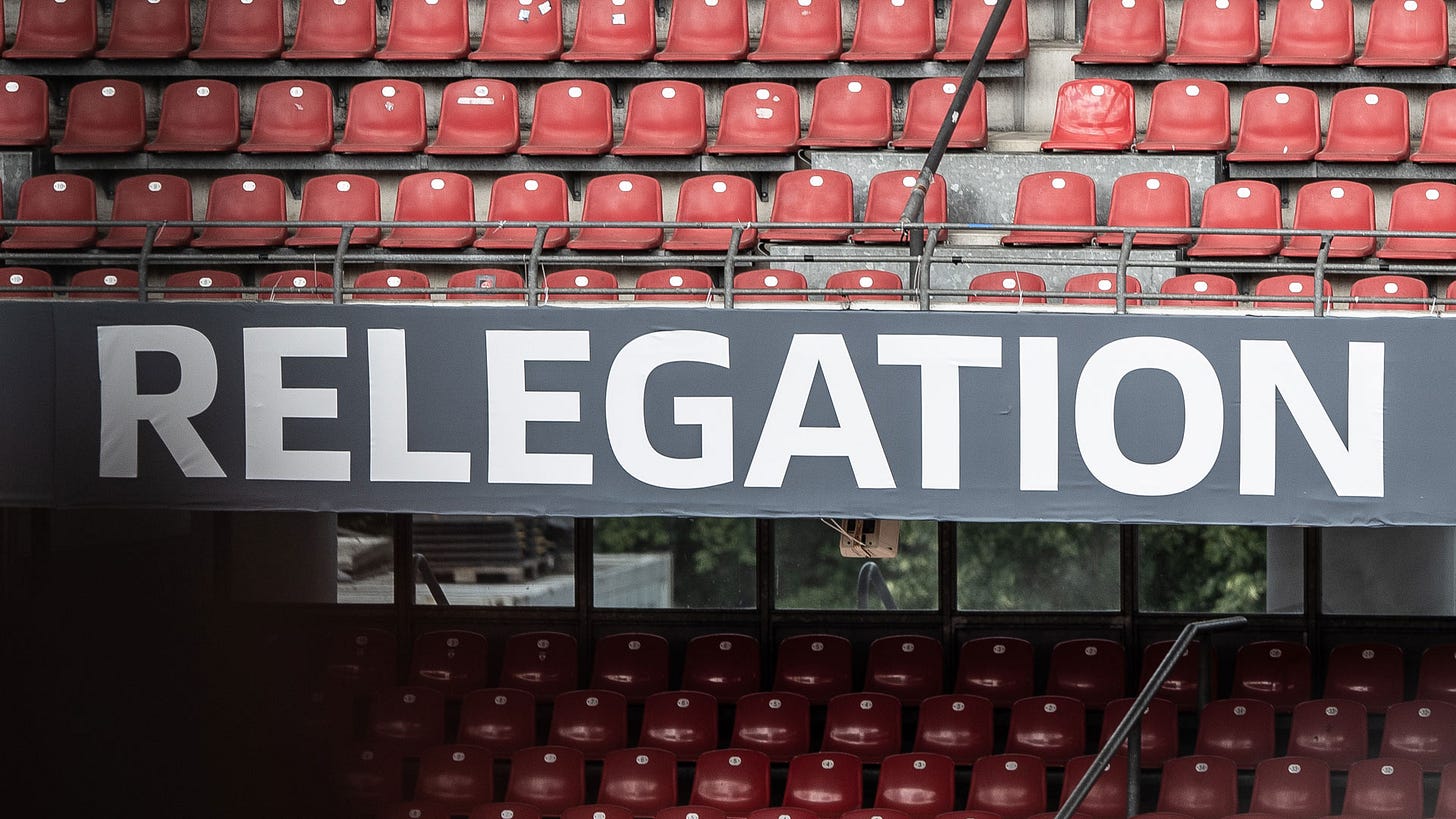The Dirty Secret Of The *NSYNC POP Slot Game | Our Unapologetic MLB Relegation Model
Where we remind you how wealthy Justin Timberlake is, and share our plan to make Major League Baseball relevant
Game Review: *NSYNC POP Slot
BY COLE RUSH
A few months ago, I was assigned a review of Play’n GO’s *NSYNC POP slot. Par for the course—I gobble up slot reviews like Cookie Monster devours chocolate chip cookies.
Any slot review involves, y’know, playing the slot in question (though I’d guess many sites don’t even require this of their writers, which is a post for another time). These reviews also closely examine the slot’s pay lines and symbol values.
Here, in the dregs of the *NSYNC POP slot’s game rules, I uncovered a semi-secret hidden in plain sight: licensed slots have been quietly ranking their subjects by value for years.
Here, we have a breakdown of symbol values in *NSYNC POP, assuming a $2 bet. For those who missed the boy band days, the members from left to right are:
Justin Timberlake
JC Chasez
Lance Bass
Joey Fatone
Chris Kirkpatrick
Timberlake enjoys a headlining spot in the slot; he’s tied highest value symbol in the game and only matched by the WILD symbol (aka the entire gosh-danged band). Following a step down with a max payout of 8x is JC Chasez. Bass, Fatone, and Kirkpatrick have equal pay structures.
*NSYNC POP (the slot) was released in 2022, about 21 years after its namesake CD flooded Best Buys and Sam Goody stores (RIP) worldwide.
How do those values stack up? They imply a clear hierarchy of former *NSYNC members, so let’s start at the top.
Justine Timberlake deserves his spot at the apex of the *NSYNC food chain, and I’d wager nobody will argue with me on this. If they did, they’d probably be coming from a place of personal nostalgia.
Timberlake parlayed his *NSYNC fame into a bustling career that spans acting gigs (The Social Network is my favorite JT film, for what it’s worth), voiceover roles, and—of course—musical success. Timberlake has 39 Grammy nominations and 10 wins. Current estimates say Timberlake’s net worth is $250 million.
All fine and dandy, but the real kicker here? Timberlake is arguably the only original *NSYNC member who became a lasting household name. He earns his spot in the slot’s ranking.
If you asked me before I started researching this piece, JC Chasez wouldn’t have cracked the top three of my personal *NSYNC member rankings. That all changed when I saw this picture, courtesy of People.
Love a guy who loves cats! Chasez worked on a marketing campaign for Meow Mix, which, in some very, very small circles, is enough to place him at number two in the Play’n GO slot’s value rankings.
Chasez was Timberlake’s classmate in the Mickey Mouse Club before joining *NSYNC. Chasez’s post-boy-band career includes a middling solo outing and a stint as a judge on MTV’s America’s Best Dance Crew. Chasez dabbles in acting and continues to produce for various artists. His estimated net worth is $16 million.
JC’s placement as the second-highest symbol value surprises me, especially considering some of the accolades of his former bandmates. My wife, however, disagrees. “This is correct,” she said when I showed her the rankings. She knows her stuff; *NSYNC was her first-ever concert.
Now we go fishin’ and catch ourselves a Bass. Lance Bass, that is. His estimated net worth is $20 million, and his music career (mostly) started and ended with *NSYNC. Bass appeared in various movies and TV shows as a cameo or guest star. He voiced Sephiroth in Kingdom Hearts, a fact I just discovered and am thoroughly tickled by. Bass placed third in Dancing With the Stars season 7.
Bass may remain well-known to *NSYNC fans, but his post-band career includes a roulette-wheel of C-list projects: reality TV appearances, novelty cameos, and a podcast. For some Lance Bass-related laughs, check out his personal assistant on Netflix’s The Circle—she plays the game as Bass; hilarity ensues.
Anyway, Bass being tied for the lowest-value symbol feels right.
Joey Fatone is my favorite non-Timberlake member of *NSYNC. I vaguely remember an MTV Cribs episode about his house, and he seemed like a nice enough guy. I also enjoyed The Singing Bee, which Fatone hosted. He also served as the Family Feud announcer from 2010 to 2015. Like Lance Bass, Fatone competed on Dancing With The Stars (season 4), beating out his bandmate by placing second. Alongside these gigs, Fatone has hosted a handful of game shows and red carpet events. He was the Rabbit on season one of The Masked Singer, America’s number-one place for has-been career rehabilitation (sorry Joey, I still love you).
I’d put Joey’s symbol a step above Lance’s if I was in charge of slot development, but I can also admit to my personal bias.
Finally, we come to Chris Kirkpatrick, who originated *NSYNC but gets the last billing in the *NSYNC POP slot. Kirkpatrick would go on to appear on many reality shows, both as a host and contestant—perhaps most notably Celebrity Big Brother and The Masked Singer, the latter of which saw him sing as a hummingbird. The real millennials know Kirkpatrick as the voice of Chip Skylark from Nickelodeon’s The Fairly Oddparents. “My Shiny Teeth And Me” was, is, and will always remain a BANGER:
So what’s the point? Honestly, Odd Balls readers, there isn't one. This post is like life—long, winding, and ending without much purpose. Maybe I just wanted to dive deeper into the *NSYNC canon. Maybe this is a minor intriguing phenomenon found in slots around the gambling world. I’m inclined to believe the latter; look at any pop-culture slot game’s symbol values for a sly takedown of the fandom’s key members.
The Unapologetic MLB Relegation Plan
BY DAN HOLMES
For many sports fans in the U.S., baseball is an old sport for old people. It’s slow, boring, and reminiscent of a time when Americans wore straw hats and went to town in a horse-drawn wagon. YEEHAW!
The NFL is clearly the most popular sport in the United States. Even the NFL schedule reveal is bigger news than what's happening in Major League Baseball that day. The NFL Draft is one of the ten most-watched sporting events each year. The Super Bowl is the most watched, most bet-on sporting event in North America. Meanwhile, baseball has been struggling to find a new generation of fans.
How can baseball become relevant?
Is there anything that could inject new life into MLB? How can the sport engender itself to younger fans, with shorter attention spans and more entertainment options than ever? How many questions can I ask in one paragraph?
Relegation, that’s how. It works in the world’s most popular sport, and it could work in MLB.
How relegation works: a primer
Relegation in soccer (fútbol or football to the rest of the planet) is like the ultimate “try again next year,” but with much higher stakes. It’s a system that ensures no team can rest on its laurels. We all know how painful resting on a laurel can be.
Here’s how it works:
At the end of each season, the teams at the bottom of the league standings are demoted to a lower division. Think of it as being sent to the kids' table at a family dinner because you couldn't keep up with the adults. For instance, in the English Premier League, the three teams that finish at the bottom are relegated to the EFL Championship, the tier just below.
Conversely, the top teams from the lower division get promoted, taking the places of those that flopped. This keeps the competition fierce and the stakes sky-high throughout the season. Every game counts—literally.
For fans, this means the thrill of seeing underdogs rise and the drama of watching established teams sweat bullets to avoid the drop.
In essence, relegation injects a thrilling blend of hope and fear into the season, ensuring that complacency is a dangerous luxury no team can afford. It’s like The Bachelor, soccer style.
MLB for the 21st Century: Relegation and Promotion
Currently, MLB has 30 teams, with (reportedly) plans to add two more in coming years. But only one team can be a champion each season, and in many years, only a handful of teams have a realistic chance to contend for a title.
MLB always has way too many franchises “rebuilding” on their way to “hopefully” becoming contenders. Some franchises never seem to get their act together (we’re looking at you, Pittsburgh and Detroit), which means fans in those cities are stuck watching baseball that doesn’t mean anything, summer after summer.
With relegation and promotion, the urgency to be competitive is baked into the sport. Like Macadamia nuts in your cookies.
The relegation plan for baseball:
Add two teams, perhaps in Charlotte and Nashville.
Split the teams into two leagues: one with 22 teams; the other with 10. Name the 22-team league “MLB Premium” and the other “MLB Choice” or something like that. The names can be almost anything—I’m just spitballing.
The 22-team league has the best franchises, those that have had success in recent years and proven to be competitive consistently. Here’s a list of franchises that would certainly be in MLB Premium: Yankees, Dodgers, Braves, Astros, Rays, Phillies, Red Sox, Cardinals, Rangers, Cubs, Giants, Padres, Guardians, Mets, Orioles, Brewers, Blue Jays, Twins, and so on. Eventually as the league expands again, MLB Premium would have as many as 24 teams.
In MLB Choice we place the franchises that have failed to show they are willing to compete. Think of the A’s, Tigers, Rockies, Pirates, Reds, Marlins, Royals, White Sox, and the others. Choosing which teams to place here would be controversial at first, but if a team ends up in MLB Choice, they have a strong incentive to get better and move up. We’ll see why below.
MLB Premium teams will compete to win the traditional World Series we all know. That would be the postseason tournament that takes place after the regular season. The regular season is for finding out who qualifies for the playoffs AND which teams remain in MLB Premium. The bottom four teams are relegated to MLB Choice. Any team that wins a playoff series earns a two-year exemption from relegation.
MLB Choice teams play a regular season made up of games against each other and the MLB Premium MLB teams (so every team still gets to play rivals and so on). At the end of the Choice season, the top four teams earn the right to play for a Choice Series title. They also earn promotion to MLB Premium. The winner of the Choice Series is exempt from being relegated for three years.
National TV contracts are built around the two leagues: MLB Premium franchises share in a larger pie of money, while MLB Choice teams have less money from revenue sharing and media deals.
A system like this places strong pressure on MLB owners to make their teams competitive.
The issue with the status quo
Currently, many owners realize that they can put a mediocre product on the field and still make oodles of money from rev sharing and local broadcast contracts.
Fans would quickly be attracted to the urgency of MLB's relegation/promotion system. Every season, four teams would lose their place in MLB Premium, and four teams would have an opportunity to jump up. Many teams might be in danger during the final weeks of the regular season, making the season more important.
Speaking of the season: MLB needs to make a hard decision to stay relevant. Baseball cannot keep playing a 162-game season that stretches from late March to early November. This sport isn’t meant to be played in a blizzard.
Many fans don’t pay attention to the start of baseball season because NCAA March Madness is happening.
By October, the behemoth that is the NFL has taken up the headlines. MLB should shorten the regular season so it ends in September, and play the World Series (and new Choice Series) in that month, when the NFL is only just getting started.
My plan gives baseball two championship events AND the added drama of promotion/relegation. Both of those features would inject life into Major League Baseball. This system would be fun for the fans, and eventually, MLB could add a third or even fourth league, where teams from smaller markets could, if they choose, compete to be promoted, until one day we may see the El Paso Chihuahuas or Toledo Mud Hens in the World Series. PLAY BALL.








